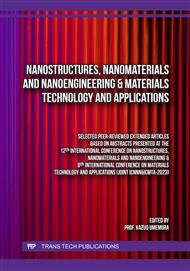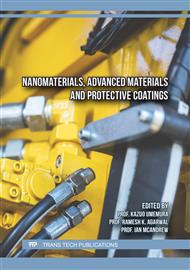[1]
A. Götz, V. Senz, W. Schmidt, D. Koper, N. Grabow, S. Illner, in: Detection of coustic emission from nanofiber nonwovens under tensile strain – An ultrasonic test setup for critical medical device components, Journal of the Mechanical Behavior of Biomedical Materials, Vol. 140 (2023)
DOI: 10.1016/j.jmbbm.2023.105720
Google Scholar
[2]
M.P. Jones, A.C. Lawrie, T.T. Huynh, P.D. Morrison, A. Mautner, A. Bismarck, S. John, in: Agricultural by-product suitability for the production of chitinous composites and nanofibers utilising Trametes versicolor and Polyporus brumalis mycelial growth, Process Biochemistry, Vol. 80, pp.95-102 (2019)
DOI: 10.1016/j.procbio.2019.01.018
Google Scholar
[3]
V. Rahmanian, T. Pirzada, E. Barbieri, S. Iftikhar, F. Li, S.A. Khan, in: Mechanically robust, thermally insulating and photo-responsive aerogels designed from sol-gel electrospun PVP-TiO2 nanofibers, Applied Materials Today, Vol. 32 (2023)
DOI: 10.1016/j.apmt.2023.101784
Google Scholar
[4]
S. Tsai, W. Wu, H. Sota, T. Hirogaki, and E. Aoyama, in: Investigation of Air Filter Properties of Flash-Spinning Nanofiber Non-Woven Fabric, International Journal of Automation Technology, Vol.16, No.5, pp.654-665 (2022)
DOI: 10.20965/ijat.2022.p0654
Google Scholar
[5]
W. Wu, E. Aoyama, T. Hirogaki, M. Ikegaya, T. Echizenya and H. Sota, in: Production of Nano Fiber Non-Woven Fabric and Investigation for Oil Adsorption and Sound Absorbing Properties, Proceedings of the Japan Society of Precision Engineering, Vol. 2017Autumn, pp.639-640 (2017) (in Japanese)
DOI: 10.1299/jsmekansai.2018.93.519
Google Scholar
[6]
B. Kołodziej, M. Bryk, K. Otremba, in: Effect of rockwool and lignite dust on physical state of rehabilitated post-mining soil, Soil and Tillage Research, Vol. 199 (2020)
DOI: 10.1016/j.still.2020.104603
Google Scholar
[7]
Q. Zhao, J. Tao, R. Yam, A. Mok, R. Li, C. Song, in: Biodegradation behavior of polycaprolactone/rice husk ecocomposites in simulated soil medium, Polymer Degradation and Stability, Vol. 93, Issue 8, pp.1571-1576 (2008)
DOI: 10.1016/j.polymdegradstab.2008.05.002
Google Scholar
[8]
M. Nofar, D. Sacligil, P. Carreau, M. Kamal, M. Heuzey, in: Poly (lactic acid) blends: Processing, properties and applications, International Journal of Biological Macromolecules, Vol. 125, pp.307-360 (2019)
DOI: 10.1016/j.ijbiomac.2018.12.002
Google Scholar
[9]
A. Ashothaman, J. Sudha, N. Senthilkumar, in: A comprehensive review on biodegradable polylactic acid polymer matrix composite material reinforced with synthetic and natural fibers, Materials Today: Proceedings, Vol. 80, Part 3, pp.2829-2839 (2023)
DOI: 10.1016/j.matpr.2021.07.047
Google Scholar
[10]
X. You, H. Wang, J. He, K. Qi, in: Fluorine-free and breathable polyethylene terephthalate/polydimethylsiloxane (PET/PDMS) fibrous membranes with robust waterproof property, Composites Communications, Vol. 40 (2023)
DOI: 10.1016/j.coco.2023.101621
Google Scholar
[11]
V. Fernández-Cabanás, A. Delgado, J. Lobillo-Eguíbar, L. Pérez-Urrestarazu, in: Early production of strawberry in aquaponic systems using commercial hydroponic bands, Aquacultural Engineering, Vol. 97, (2022)
DOI: 10.1016/j.aquaeng.2022.102242
Google Scholar
[12]
A. Gül, H. Özaktan, F. Kıdoğlu, Y. Tüzel, in: Rhizobacteria promoted yield of cucumber plants grown in perlite under Fusarium wilt stress, Scientia Horticulturae, Vo. 153, pp.22-25 (2013)
DOI: 10.1016/j.scienta.2013.01.004
Google Scholar



